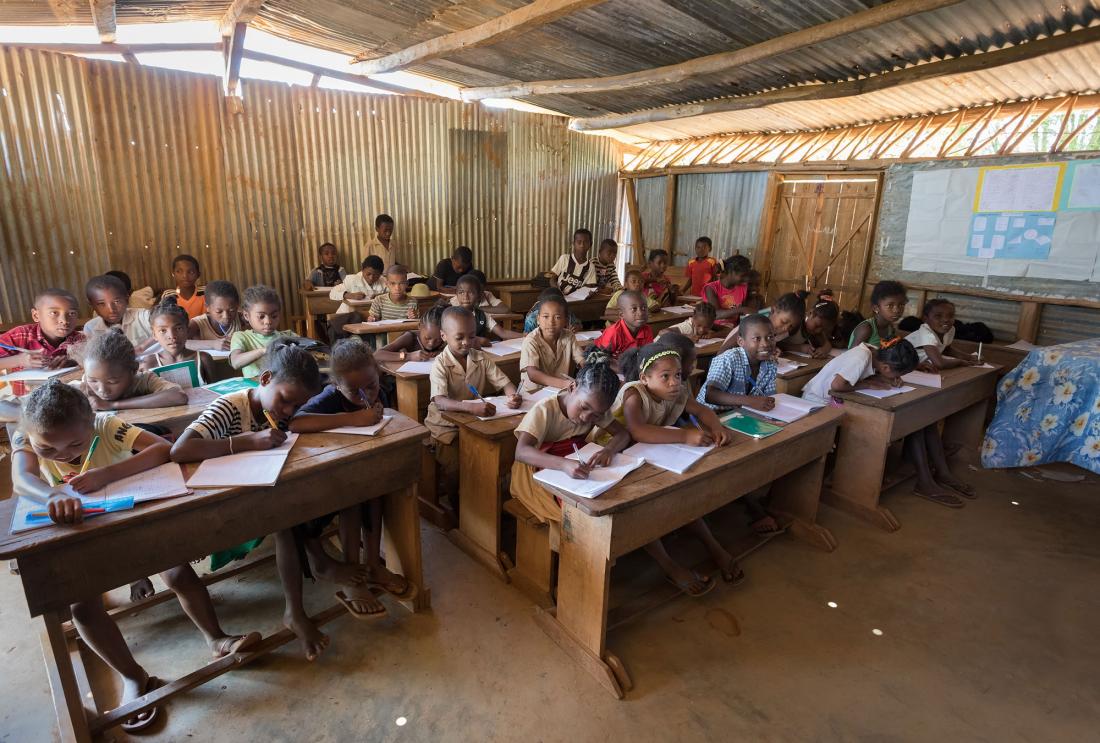La Administración de la Educación Primaria en Madagascar
- Primary schools
- Teachers
- Student learning
- Training
- Community monitoring
Problema de política pública
Contexto de la evaluación

Detalles de la intervención
Researchers analyzed the results of a previously conducted randomized evaluation (Lassibille et al., 2010) that was conducted with the Ministry of Education in Madagascar and the World Bank. Researchers randomly introduced the AGEMAD program across 3,774 primary schools in thirty public school districts, selected for their similarity and ease of access
The AGEMAD program consisted of three distinct interventions, which each provided methods and materials that were designed to help various employees of the Ministry of Education improve their management, and, ultimately, improve educational outcomes such as student learning and test scores. The interventions were as follows:
- District-level intervention: District heads and other administrators received operational tools and training that included forms for supervision visits to schools, procurement of pedagogical supplies, and a teacher transfer master sheet.
- Subdistrict-level intervention: In some subdistricts that also received the district-level intervention, the subdistrict head was trained and provided with tools to supervise school visits, as well as information on the performance and resource-level at each school.
- School-level intervention: In some schools that also received the district- and subdistrict-level interventions, teachers received educational and administrative tools, including lesson planning forms, records of student attendance and learning, and reports to parents and school directors. School directors were also provided with attendance, student performance, and community meeting tools. Additionally, school meetings were held to discuss school report cards and encourage community involvement in monitoring school quality.
- Comparison group: Schools in the comparison group did not receive any of the interventions at the district-, subdistrict-, or school-level.
Intervention By Group:
| Group | Number of districts | Number of subdistricts | Number of schools | Description of intervention |
| Comparison | 15 | 207 | 1721 | No intervention |
| District-level intervention | 15 | 170 | 1314 | District-level intervention |
| Subdistrict-level intervention | 15 | 89 | 436 | District and subdistrict-level intervention |
| School-level intervention | 15 | 89 | 303 | District, subdistrict, and school-level intervention |
To analyze the impact of the management reforms on student learning outcomes based on teacher type, researchers averaged student test scores in French, Malagasy, and mathematics that were given to third-grade students in 2005/06 and fourth-grade students in 2006/07. The same tests were administered to teachers in 2005/06 and 2006/07, to verify whether those who were supposed to grade the students’ tests knew enough to do so. Researchers also gathered basic information about the teachers, including whether they were contractual or civil servant teachers, their age, their years of experience, whether they have a high school diploma, and if they have formal pedagogical training.
Resultados y lecciones de la política pública
Impacto con el enfoque de “abajo-arriba”: las intervenciones a nivel de escuela llevaron a una mejora considerable en el comportamiento del profesor. Era más probable que los profesores hicieran planificaciones diarias y semanales de las materias y que las analizaran con su director (con una desviación estándar promedio de 0,26). Los puntajes de las pruebas fueron mayores que las del grupo de comparación, con una desviación estándar de 0.1, dos años después de postular al programa. Además, la asistencia de los estudiantes aumentó 4,3 puntos porcentuales comparados al promedio de un 87% correspondiente al grupo de comparación, aunque la asistencia de los profesores y la comunicación con los padres no mejoraron.

